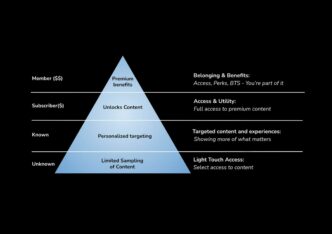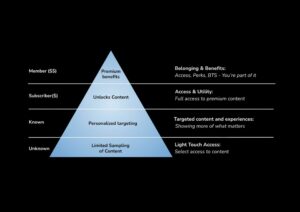

ARPU… one of the most closely monitored and highly appreciated KPIs for e-commerce marketing teams across all sectors. It has to be said that this ratio has the dual advantages of being easy to calculate and of having a very concrete meaning.
A quick reminder for those returning from vacation: ARPU, average revenue per user, is calculated by taking the sales over a period divided by the total number of users.
It’s very useful on e-commerce sites to calculate the average basket per customer. For example, for a site like Amazon, it lets you know how much a person using the platform will spend on average per month. In the case of a subscription-only site such as Netflix, ARPU can be used to calculate the average subscription paid by a user, and uncover whether the various packages on offer match demand. The metric also makes it easy to make sales projections based on future audience estimates.
The use of ARPU has become so widespread that it’s also a key indicator for the digital media sector, so much so that it is often the subject of discussion between people in the profession who like to compare their ARPUs to demonstrate the good health of their business.
There is, however, an important specificity with the publishing industry to bear in mind when it comes to this metric.
The ARPU principle only works if there’s a correlation between the two numbers in the ratio, otherwise it doesn’t mean much. Which isn’t the case for media businesses, where revenue is quite independent of audiences.
Going back to basics
I can already see you spitting out your coffee. So let me explain.
For a media site that’s 100% closed via a paywall, ARPU makes sense and is an accurate representation of average revenue per user. On the other hand, for a site that relies heavily on an advertising model, things get more complicated.
First of all, we need to agree on the term “users”. On a freely accessible site, a user is the equivalent of a single visitor. However, for the rest of this article, I prefer to use the term “visits”. We all know that there’s a bias towards “anonymous” unique visitors, due to the fact that cookies aren’t stored. So I’m going to use the ARPU formula: Revenues over one month / visits over the month.
Note that this doesn’t change the reasoning at all, and that you could use unique visitors instead, or page views. Incidentally, I’ve already seen the three different cases in different media, which renders any comparison with your neighbor null and void, since you’re not comparing the same thing.
Anyway, let’s continue.
Now that we’ve defined the denominator (visits), let’s look at the numerator (revenues).
In the case of a free (or mixed) model, this is essentially advertising revenue. Even though advertising networks have always known how to complicate things (direct and indirect programmatic, Open Auction…), we’re going to divide advertising revenue into just two parts: revenue negotiated directly by the network and indirect revenue (everything that hasn’t been negotiated upstream).
As I said earlier, advertising network revenues are not correlated with audience figures. For this to be the case, site fill rates would have to be 100%, but this is never the case, as we’ll see.
Let’s focus on the fill rate. This is the percentage of advertising space sold on the site in relation to the total inventory available on the site. Already, a 100% fill rate is impossible for the usual reasons: ad blockers, refusing tracking via the CMP, poor internet connection preventing ads from loading…
So the maximum achievable rate is between 60% and 70%. Then there’s the part actually filled by the advertising network and the part filled by the “not sold”, commonly known as indirect programmatic.
The bigger the audience for the site sold by the advertising network, the lower the fill rate. It’s simple: trees don’t grow on trees, and even if advertising agencies sign as many advertising campaign contracts as they can, when a site achieves hundreds of millions of page views per month with two or three advertising formats, it’s easy to understand that it’s practically impossible for sales staff to fill everything. What’s more, advertisers may not want to run their campaigns in certain sections, preferring to concentrate on others.
So even if no advertising network gives its fill rate, no one is fooled: the fill rate is, at best, around 30%, the rest being filled by indirect advertising with a much lower CPM, from five to ten times lower, depending on the quality of the site.
(As a reminder, CPM, or “cost per thousand”, corresponds to the price paid by an advertiser to display an ad a thousand times on a site).
> Determining the optimal price for your subscription product
Putting this into context
Let’s take the example of a site with a large audience of 100 million visits per month and a high fill rate of 25%, generating 500K euros in revenue per month from advertising sales. We’ll add another 100K euros from indirect sales.
So its ARPU is 600K / 100M = 0.006 euros per visit.
Now, suppose there’s a major crisis in this medium and the audience drops by half (that’s all). Would revenues drop by that much? Certainly not.
As the fill rate was initially 25%, if the advertising network sells as many advertising campaigns, the rate will rise to 50% for the same sales of 500K euros. On the other hand, there’s not much inventory left for indirect sales, which will rise to 50K euros.
So ARPU becomes: 550K / 50M = 0.011 euros per visit.
If we look at ARPU alone, we can break out the champagne. It has almost doubled. Except that in real life, audiences have collapsed.
Now let’s assume an exogenous event, such as most advertisers finally deciding to invest more in retail sites and social platforms rather than press sites (any resemblance with reality would be purely coincidental).
The audience remains stable in this scenario at 100M visits per month, and the fill rate halves to 12% for 250K euros in sales. So there’s more inventory for indirect programmatic, which increases to 200K euros.
Let’s calculate ARPU: 450K / 100M = €0.0045
In this case, it has indeed fallen, but not linearly, and ARPU would be a good indicator, since one visit generates less revenue. All hands on deck, we need to improve ARPU to get back to previous levels!
Well, I’ve got a simple solution for the next month: let’s write fewer articles or articles of lower quality. In other words, let’s halve the audience, as in our previous example. Advertising sales will remain at 250K euros (since the fill rate is low, there’s room to keep the same sales), indirect sales will drop by half to 100K.
After all these good editorial actions, our ARPU is 350K / 50M = 0.007€. Perfect, we can congratulate ourselves, it’s never been so good while audiences and revenues have collapsed.
Obviously, I’ve simplified and exaggerated a little, but we can see here that ARPU only makes sense at the moment it’s calculated. If it then goes up or down, this in no way means that business is good, and vice versa.
Taking a closer look
The main criticism of my reasoning concerns the fill rate. For the time being, we’ve been assuming that the site is only 30% full, and that most of it is unsold. However, advertising agencies often report that inventories are full and that they are unable to deliver campaigns. We’ve all experienced it. Why is this?
As I said earlier, it’s mainly because advertisers will often focus on certain sections that are more attractive than others, and for understandable reasons. People prefer to advertise in a safe environment, such as lifestyle or parenting, than in more risky sections dealing with the Israeli-Palestinian conflict.
This means that some sections of a site will be full, while others will struggle to fill up with advertising.
If we focus our ARPU on a section with a maximum fill rate (excluding ad blockers and the other joys mentioned above), ARPU works because the correlation between revenues and visits is perfect. If audiences rise, we deliver more ads, and vice versa.
On the other hand, for our war column, where no advertiser wants to go, revenues will remain hopelessly empty. Audiences may triple or halve, but there will be no impact on revenues, and ARPU will be meaningless (because it will increase as audiences fall).
A conclusion that has absolutely no link to the introduction
Clearly, ARPU is only of interest in special cases where the sections are 100% filled with advertising sold by the advertising network.
But in the end, we’ve just answered a question that we weren’t asking ourselves at the start of the paper: how do you choose whether an article should be free or premium, i.e. blocked by a paywall or not?
It’s a truism, but let’s face it: if a column generates a lot of traffic but attracts few advertisers, clearly the paywall is the way to go.
On the other hand, for sections with high audience and advertising potential (lifestyle, sports, culture…) it’s clearly better to leave articles free. By putting them under paywall, they are less visible under Google Discover (which favors articles without paywall), so you’re depriving yourself of a large part of the audience, and therefore revenue. What’s more, even if a brand’s strategy is subscription, they have to come to the site to get to know it, get used to using it and even the holy grail: download the app. After that, there’s no stopping the user from becoming a subscriber.
It’s a common misconception that a free article is not as good as a subscriber-only article, because quality has to be paid for. But in reality, a free and interesting (an essential component) article has the advantage of bringing in a high CPM (since it’s sold by the advertising network and not indirectly by programmatic means), and is a great gateway to building user loyalty and, ultimately, will be the first bridge to subscription.
The real conclusion
For those who feel cheated by my conclusion, I’ll end by saying that fortunately media companies don’t just track ARPU, but also sales and audiences separately, which are naturally much better indicators.
Then you could retort that ARPU is mainly used to compare with your neighbor without giving your revenue figures. Except that site audiences are public via the ACPM, so it’s not very difficult to find revenues…












